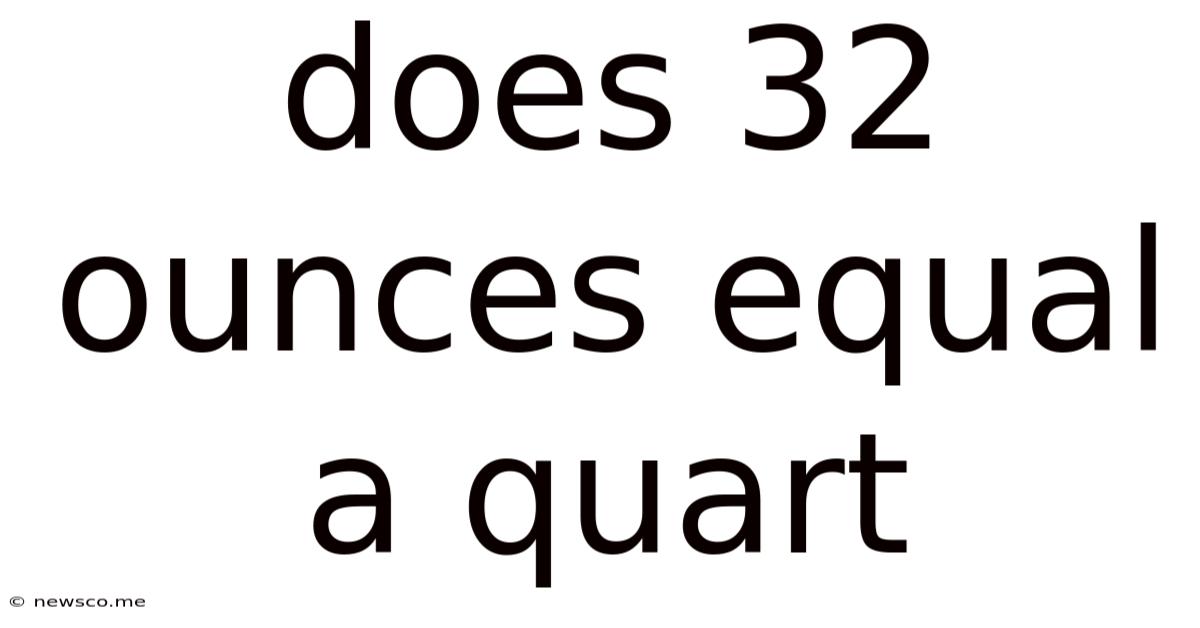Does 32 Ounces Equal A Quart
News Co
May 07, 2025 · 4 min read

Table of Contents
Does 32 Ounces Equal a Quart? A Comprehensive Guide to Liquid Measurement
The question, "Does 32 ounces equal a quart?" is a common one, especially when dealing with cooking, baking, or any task involving liquid measurement. The simple answer is yes, but understanding the nuances behind this equivalence is crucial for accurate measurements and avoiding potential confusion. This comprehensive guide will delve deep into the world of liquid measurements, exploring the relationship between ounces and quarts, and clarifying any related ambiguities.
Understanding Units of Liquid Measurement
Before diving into the specifics of ounces and quarts, let's establish a foundational understanding of common liquid measurement units. The most frequently encountered units in the United States Customary System (USCS) include:
-
Fluid Ounce (fl oz): The smallest unit commonly used for liquid measurement. It's a volume unit, not a weight unit, although the weight of a fluid ounce will vary depending on the liquid's density.
-
Cup (c): Equal to 8 fluid ounces. Often used in cooking and baking recipes.
-
Pint (pt): Equal to 16 fluid ounces, or 2 cups.
-
Quart (qt): Equal to 32 fluid ounces, or 2 pints, or 4 cups.
-
Gallon (gal): The largest unit commonly used, equal to 128 fluid ounces, 8 pints, 4 quarts, or 16 cups.
The Relationship Between Ounces and Quarts: A Detailed Breakdown
The core of our exploration lies in the direct relationship between ounces and quarts. As stated earlier, 1 quart is precisely equal to 32 fluid ounces. This conversion is fundamental in countless applications, from converting recipes to calculating liquid quantities in various containers. Let's look at some illustrative examples:
-
Converting quarts to ounces: If you have 2 quarts of milk, you have 2 quarts * 32 fl oz/quart = 64 fluid ounces of milk.
-
Converting ounces to quarts: If you have 96 fluid ounces of juice, you have 96 fl oz / 32 fl oz/quart = 3 quarts of juice.
This straightforward conversion is vital for accuracy. Using the wrong conversion can lead to significant errors, especially in situations requiring precision, such as in scientific experiments or industrial processes.
Potential Sources of Confusion: Weight vs. Volume
A common pitfall when working with liquid measurements is confusing weight and volume. While related, they are distinct concepts. An ounce as a unit of weight (oz) is different from a fluid ounce (fl oz) as a unit of volume. The weight of a fluid ounce of a substance depends on the substance's density. For example, a fluid ounce of water weighs approximately 29.6 grams, while a fluid ounce of honey will weigh significantly more due to honey's higher density.
Therefore, it's crucial to always specify whether you're referring to weight or volume when using the term "ounce." In the context of liquid measurements, it's almost always understood to mean "fluid ounce."
Practical Applications: Recipes, Containers, and More
Understanding the 32-ounce-to-quart equivalence has wide-ranging practical applications:
Cooking and Baking:
Recipes often provide ingredient quantities in both ounces and quarts. Being able to easily convert between these units is essential for accurate measurements and achieving the desired results. Incorrect conversions can lead to dishes that are too watery, too thick, or otherwise unpalatable.
Beverage Industry:
The beverage industry extensively uses quarts and ounces for packaging and labeling. Knowing the conversion is critical for accurate filling, labeling, and pricing.
Scientific Experiments and Industrial Processes:
In scientific settings, precise liquid measurements are paramount. The conversion between ounces and quarts is often used in experiments involving solutions and reagents. Similarly, industrial processes relying on liquid components often require accurate conversion for efficiency and quality control.
Everyday Life:
Even in everyday life, understanding this conversion can be helpful. For instance, knowing that a quart of milk contains 32 ounces can help you choose the appropriate container size for your needs or determine if you have enough milk for a recipe.
Beyond the Basics: Exploring Other Liquid Measurement Systems
While the USCS system is prevalent in the United States, other countries predominantly use the metric system. The metric system uses liters (L) and milliliters (mL) for liquid volume. Understanding how these units relate to ounces and quarts is crucial for international collaboration and trade.
Here's a brief comparison:
-
Liter (L): Approximately 33.8 fluid ounces or 1.057 quarts.
-
Milliliter (mL): 1/1000 of a liter. Often used for smaller volumes.
Converting between USCS and metric units requires using conversion factors. Online conversion tools are readily available for accurate conversions between these different systems.
Conclusion: Mastering Liquid Measurement Conversions
The statement "32 ounces equal a quart" is a fundamental truth in liquid measurement. Understanding this equivalence and the broader context of liquid measurement units is essential for accuracy in various settings, from everyday cooking to scientific experiments. By mastering these conversions and appreciating the distinction between weight and volume, you equip yourself with the skills necessary for accurate and efficient handling of liquid quantities. Always double-check your conversions to avoid errors that can impact your results.
Latest Posts
Latest Posts
-
Plot The Numbers On The Number Line
May 08, 2025
-
7 Faces 15 Edges 10 Vertices
May 08, 2025
-
Convertir 45 Grados Celsius A Fahrenheit
May 08, 2025
-
Equation Of Plane In Vector Form
May 08, 2025
-
What Is The Measure Of P
May 08, 2025
Related Post
Thank you for visiting our website which covers about Does 32 Ounces Equal A Quart . We hope the information provided has been useful to you. Feel free to contact us if you have any questions or need further assistance. See you next time and don't miss to bookmark.